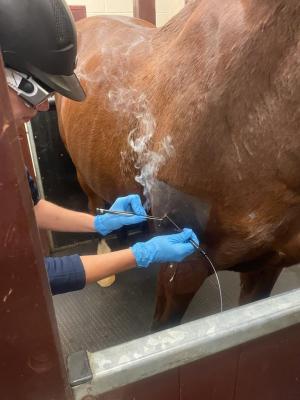Why Equine Therapy is Coming To Be a Preferred Alternative for Emotional Health
Why Equine Therapy is Coming To Be a Preferred Alternative for Emotional Health
Blog Article
Just How Laser Treatment in Equine Therapy Is Transforming Vet Look After Equines
Laser therapy has emerged as a transformative technique in equine veterinary treatment, giving a non-invasive option that speeds up healing and boosts total health and wellness. The mobility and adaptability of laser therapy devices further emphasize their growing necessity amongst vets.

Understanding Laser Treatment
Comprehending laser therapy is vital for appreciating its role in equine treatment. Laser treatment, likewise referred to as photobiomodulation, entails the application of certain wavelengths of light to cells, which can cause various biological effects. This restorative method harnesses the power of light energy to penetrate the skin and underlying tissues, stimulating mobile procedures and improving tissue repair work.
The innovation behind laser therapy is grounded in the concept of photochemistry, where photons are soaked up by chromophores within cells, bring about enhanced ATP manufacturing and inflection of reactive oxygen types. This, in turn, advertises cellular spreading, decreases inflammation, and accelerates recovery. Vet experts utilize various kinds of lasers, including low-level lasers (LLLT) and high-power Class IV lasers, depending upon the particular healing goals and the nature of the equine problem being dealt with.
Different laser wavelengths and power setups are thoroughly selected to target numerous cells depths and attain wanted scientific outcomes. Security procedures are critical, as incorrect usage can result in thermal damages or suboptimal therapeutic impacts. Thus, a detailed understanding of laser therapy's mechanisms and applications is essential for its reliable implementation in equine vet technique.
Benefits for Horse Health
The myriad advantages of laser therapy for equine wellness encompass improved healing, pain decrease, and enhanced flexibility. This innovative treatment method leverages certain wavelengths of light to pass through tissues, promoting mobile function and advertising rapid cells repair service. The non-invasive nature of laser treatment guarantees minimal tension and discomfort for the horse, helping with a smoother recovery procedure.

By decreasing swelling and pain, and enhancing cells repair work, laser therapy aids in restoring joint feature and muscular tissue adaptability. Thus, laser therapy stands as a transformative device in contemporary horse veterinary treatment.
Common Conditions Treated
Laser therapy has actually emerged as a flexible treatment option for a selection of typical equine problems. Among these, musculoskeletal injuries are particularly amenable to laser therapy. Soft cells injuries, such as tendonitis and tendon strains, advantage from the anti-inflammatory and analgesic effects of laser treatments, which speed up healing and reduce discomfort. Additionally, laser treatment works for conditions like osteo arthritis, where it assists reduce joint swelling and advertise tissue repair.
Wound monitoring is one more area where laser therapy has actually shown substantial pledge. Persistent wounds or slow-healing ulcers can be particularly tough in equines, but laser therapy Find Out More enhances mobile regeneration and improves blood circulation, hence quickening the recovery process. Laser therapies have been effectively used in managing hoof conditions such as laminitis and abscesses, minimizing pain and promoting faster recovery.
Equine athletes commonly struggle with performance-related problems like muscular tissue pain and tension fractures. Laser therapy help in reducing muscle tiredness and speeds up the recovery of micro-injuries, therefore guaranteeing that steeds go back to peak efficiency faster. By dealing with these varied conditions, laser treatment is transforming the landscape of vet care, supplying a non-invasive, reliable alternative to traditional therapies.
Technology Behind Laser Treatment

Laser devices made use of in vet medication frequently use low-level laser treatment (LLLT) or cold laser therapy. Unlike high-powered medical lasers, these devices operate at reduced power levels, optimizing therapeutic advantages while minimizing thermal damages. The power from the laser light stimulates adenosine triphosphate (ATP) production, enhances cellular metabolic process, and speeds up tissue repair service procedures.
Modern laser therapy devices for equine therapy is made with adjustable setups to cater to the specific demands of various cells and my company problems. Equine Therapy. Criteria such as wavelength, power density, and therapy period can be finely tuned, supplying tailored restorative options. In addition, advancements in laser innovation have caused the growth of mobile, handheld devices, making it much easier for veterinarians to provide treatment in a selection of setups, from clinics to stables. This technological advancement is a foundation in the revolutionizing of equine vet care.
Success Stories and Instance Research Studies
Showcasing the tangible benefits of laser therapy, many success stories and instance studies illuminate its transformative impact on equine health. One such situation entails a pure-blooded racehorse struggling with chronic tendonitis. Standard therapies yielded minimal renovation, but after integrating laser treatment right into the routine, the steed exhibited considerable decreases in inflammation and pain within weeks, ultimately returning to competitive racing.
Another compelling example includes a dressage steed diagnosed with severe neck and back pain, restricting its performance. A vet group used low-level laser therapy (LLLT) to target the inflamed areas, causing marked renovation in versatility and a noteworthy decrease in discomfort. Over several sessions, the equine reclaimed its peak form, showcasing the efficiency of laser therapy in resolving musculoskeletal concerns.
In addition, a study performed at a leading equine facility checked out 50 equines with numerous soft tissue injuries treated with laser treatment. The results were striking: 85% of the equines showed sped up healing times and boosted wheelchair. These situations emphasize the versatility and efficiency of laser treatment in equine medicine, offering a non-invasive, scientifically-backed method to boosting healing and performance in horses.
Final Thought
Laser treatment is revolutionizing equine veterinary care by giving a non-invasive therapy that accelerates healing, reduces swelling, and alleviates pain. With its efficiency in dealing with a link series of problems, from musculoskeletal injuries to persistent ailments like osteoarthritis, this modern technology considerably improves equine health and mobility. The transportability and versatility of laser therapy better highlight its transformative effect on veterinary practices, solidifying its role as an essential tool in contemporary equine medical care.
Report this page